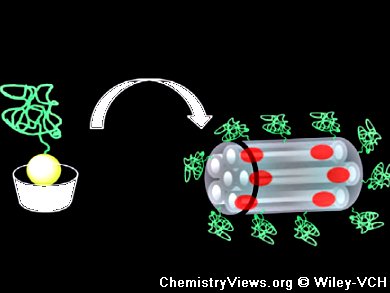Multifunctional nanocontainers for imaging, targeting, and drug release are a main research area in bio-nanomedicine. Jurriaan Huskens and colleagues, University of Twente, The Netherlands, have functionalized nanoporous zeolite L crystals with β-cyclodextrin (CD) to give multifunctional systems that have the potential for encapsulation of drug molecules inside the zeolite pores and noncovalent attachment of other, for example, targeting, ligand molecules on its surface.
Functionalization with CD was achieved by first modifying the zeolite surface with aminoalkoxysilanes. Then, 1,4-phenylene diisothiocyanate was reacted with the amino monolayer and used to bind CD heptamine by using its remaining isothiocyanate groups.
The team found that the use of two different aminoalkoxysilanes, 3-aminopropyl dimethylethoxysilane (APDMES) and 3-aminopropyl triethoxysilane (APTES), gave drastic differences in the uptake and release properties of the zeolites by affecting the accessibility of the channels for cation exchange. APTES formed an impermeable layer and blocked the diffusion of thionine dye molecules inside the crystals almost completely. On the other hand, APDMES allowed exchange of K+ ions with charged dye molecules. Thus, this approach allows ions to be permanently trapped inside the channels by using APTES, a property that is potentially useful for imaging, or the ions can be released from amino- and CD-modified zeolites if APDMES is used, thus making these zeolites interesting for drug-delivery applications.
- Cyclodextrin-Modified Zeolites: Host–Guest Surface Chemistry for the Construction of Multifunctional Nanocontainers,
Anna Szarpak-Jankowska, Christine Burgess, Luisa De Cola, Jurriaan Huskens,
Chem. Eur. J. 2013.
DOI: 10.1002/chem.201302153




